Related Research Articles

An altarpiece is an work of art in painting, sculpture or relief representing a religious subject made for placing at the back of or behind the altar of a Christian church. Though most commonly used for a single work of art such as a painting or sculpture, or a set of them, the word can also be used of the whole ensemble behind an altar, otherwise known as a reredos, including what is often an elaborate frame for the central image or images. Altarpieces were one of the most important products of Christian art especially from the late Middle Ages to the era of Baroque painting.
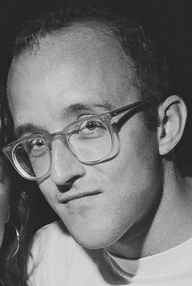
Keith Allen Haring was an American artist whose pop art emerged from the New York City graffiti subculture of the 1980s. His animated imagery has "become a widely recognized visual language". Much of his work includes sexual allusions that turned into social activism by using the images to advocate for safe sex and AIDS awareness. In addition to solo gallery exhibitions, he participated in renowned national and international group shows such as documenta in Kassel, the Whitney Biennial in New York, the São Paulo Biennial, and the Venice Biennale. The Whitney Museum held a retrospective of his art in 1997.

The Palacio de Bellas Artes is a prominent cultural center in Mexico City. This hosts performing arts events, literature events and plastic arts galleries and exhibitions. "Bellas Artes" for short, has been called the "art cathedral of Mexico", and is located on the western side of the historic center of Mexico City which is close to the Alameda Central park.

Sant Climent de Taüll, also known as the Church of St. Clement of Tahull, is a Roman Catholic church in Catalonia, Spain. It is an example of Romanesque architecture. Other influences include the Lombard and Byzantine styles, which can be seen throughout the exterior and interior of the building. The church is a basilica plan structure with three naves, each of them with a terminal apse, and large columns separating the side naves. Connecting to the church is a slim bell tower that has six floors plus a base. The artwork inside the church include the famous mural paintings by the Master of Taüll, as well as the wooden altar frontal. These works of art represent different aspects of Christianity that can also be found in many other works of art. The most famous fresco, of Christ in Majesty in the main apse of the church, has been moved to the Museu Nacional d'Art de Catalunya in Barcelona.
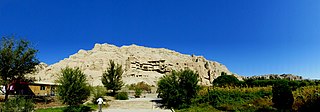
The Kizil Caves are a set of Buddhist rock-cut caves located near Kizil Township in Baicheng County, Aksu Prefecture, Xinjiang, China. The site is located on the northern bank of the Muzat River 65 kilometres west of Kucha. This area was a commercial hub of the Silk Road. The caves have an important role in Central Asian art and in the Silk Road transmission of Buddhism, and are said to be the earliest major Buddhist cave complex in China, with development occurring between the 3rd and 8th centuries CE. The caves of Kizil are the earlier of their type in China, and their model was later adopted in the construction of Buddhist caves further east. Another name for the site has been Ming-oi, although this term is now mainly used for the site of Shorchuk to the east.
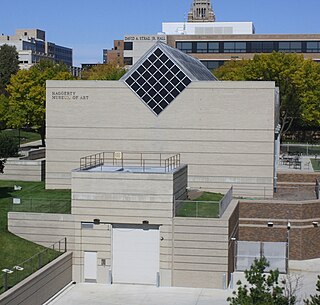
The Patrick and Beatrice Haggerty Museum of Art, sometimes referred to simply as "the Haggerty", is located at 13th and Clybourn Streets on the campus of Marquette University in downtown Milwaukee, Wisconsin, United States. The museum opened in 1984 following a university collaborative effort that was chaired by professor Curtis L. Carter. The construction site was decorated by a mural called Construction Fence by American artist and social activist, Keith Haring.

The Hermitage of San Baudelio de Berlanga is an early 11th-century church at Caltojar in the province of Soria, Castile and León, Spain, 8 km south of Berlanga de Duero. It is an important example of Mozarabic architecture for its peculiarities, and was built in the 11th century, in what was then the frontier between Islamic and Christian lands. It is dedicated to Saint Baudilus or Baudel.

Adam and Eve is the title of two famous works in different media by Albrecht Dürer, a German artist of the Northern Renaissance: an engraving made in 1504, and a pair of oil-on-panel paintings completed in 1507. The 1504 engraving depicts Adam and Eve in the Garden of Eden, surrounded by with several symbolic animals. The engraving transformed how Adam and Eve were popularly depicted in art.
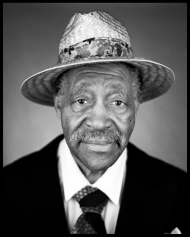
William Joshua Blackmon, also known as Prophet Blackmon, was an American street preacher and a well known Milwaukee artist. Jeffrey R. Hayes, professor of art history at the University of Wisconsin–Milwaukee, described him as "among the best self-taught artists ever to come out of Milwaukee".
Pan American Unity is a mural painted by Mexican artist and muralist Diego Rivera for the Art in Action exhibition at Treasure Island's Golden Gate International Exposition (GGIE) in San Francisco, California in 1940. This work was the centerpiece of the Art In Action exhibit, which featured many different artists engaged in creating works during the Exposition while the public watched.

CAPC musée d'art contemporain de Bordeaux, formerly the Centre d'arts plastiques contemporains (CAPC), is a museum of modern art established in 1973 in Bordeaux, France.
Nina Chanel Abney is an American artist, based in New York. She was born in Harvey, Illinois. She is an African American contemporary artist and painter who explores race, gender, pop culture, homophobia, and politics in her work.

Tower is a mural by American artist Keith Haring executed in 1987. The mural covers the exterior of a preserved stairwell from the now demolished building of the Necker-Enfants Malades Hospital in Paris, France. It is one of two public murals in France by the artist.
We the Youth is a 1987 mural by Keith Haring covering the west face of a private rowhouse in the Point Breeze neighborhood of Philadelphia, Pennsylvania. It was painted during a three-day workshop on 1, 2 and 3 September 1987. It is the only of Haring's collaborative public murals to remain in its original location. The mural was intended as a temporary placeholder until new row houses would eventually cover the wall of the mural.
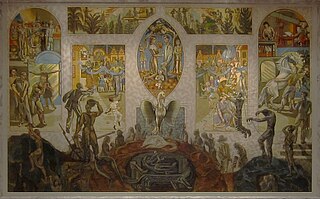
Untitled (Mural for Peace), commonly known as the United Nations Security Council mural, is an oil painting by Norwegian artist Per Krohg exhibited at the Headquarters of the United Nations in New York City since August 22, 1952. The mural, an 18' x 29' canvas located on the UN Security Council chamber's east wall, features a central image of a rising phoenix surrounded by images of war and disharmony, near the mural's bottom, and more tranquil images at the top.

Crack Is Wack is a mural created in 1986 by American artist and social activist Keith Haring. Located near the Harlem River Drive in East Harlem, the mural serves as a warning against crack cocaine use, which was rampant in major cities across the United States during the mid to late 1980s. As a symbol of anti-drug activism, Crack Is Wack commemorates Haring's powerful sociopolitical presence as an artist and remains a part of New York City's repertoire of iconic public art.

Todos Juntos Podemos Parar el SIDA is a mural created by American artist and social activist Keith Haring in 1989. The mural was painted to raise awareness to the AIDS epidemic. It is located next to the Museu d'Art Contemporani de Barcelona museum in the El Raval neighbourhood of Barcelona.

Sandeep Mukherjee is an Indian-American artist based in Los Angeles who works in the areas of painting, drawing and installation art. His work engages with the discourses of process art, textile art, modernist abstract painting and traditional Eastern art, balancing emphases on materiality, the physicality of the performing body and viewer, architectural space, and image. He is most known for his process-oriented, improvisational abstract works—often paintings in acrylic inks and paints on textured or film-like surfaces—that seek to represent mutable, flowing matter and liminal realms between subjective experience and objective information. Mukherjee's early work was figurative; his later work, while abstract, is often likened to landscape and microscopic, natural or celestial phenomena. Los Angeles Times critic Christopher Knight described it as "ecstatic abstraction, built from color, line, movement and light. Like the dance done by a whirling dervish, who positions himself between material and cosmic worlds."

Tuttomondo is a mural created by American artist Keith Haring in 1989. Located on the rear wall of the Sant'Antonio Abate church in Pisa, it is one of the last public murals executed before his death from AIDS-related complications in 1990. It is also one of the few outdoor public works created by Haring for permanent display.
The Keith Haring Mural is a mural created in 1984 by American artist Keith Haring. Located in Collingwood, Melbourne, the mural was added to the Victorian Heritage Register in 2004 for its historical, aesthetic and social significance to the State of Victoria.
References
- 1 2 3 4 5 6 7 8 9 10 11 Carter, Curtis (2005). On the Fence: Keith Haring's Mural for the Haggerty, 1983 (PDF). Haggerty Museum of Art. Archived (PDF) from the original on 2021-12-13. Retrieved 2022-05-10.
- ↑ Elisabeth Sussman (1997). Keith Haring. Whitney Museum of American Art. ISBN 9780821224663.
- ↑ "Out of the Vaults by Keith Haring // Past Exhibitions // Haggerty Museum of Art // Marquette University". www.marquette.edu. Archived from the original on 2018-05-28. Retrieved 2018-05-28.
- 1 2 Haggerty Museum of Art, Marquette University (2017-10-26), Keith Haring On the Fence, archived from the original on 2018-06-08, retrieved 2018-05-27
- ↑ John Gruen, Keith Haring: The Authorized Biography, (New York: Prentice Hall Press, 1991), p. 65.
- ↑ "Exhibition Offers Close-up View of Keith Haring Construction Fence" (PDF). Haggerty News: Newsletter of the Patrick and Beatrice Haggerty Museum of Art. Vol. 18, no. 3. Marquette University. Winter 2004. Archived from the original on 2022-08-22. Retrieved 2018-05-28.